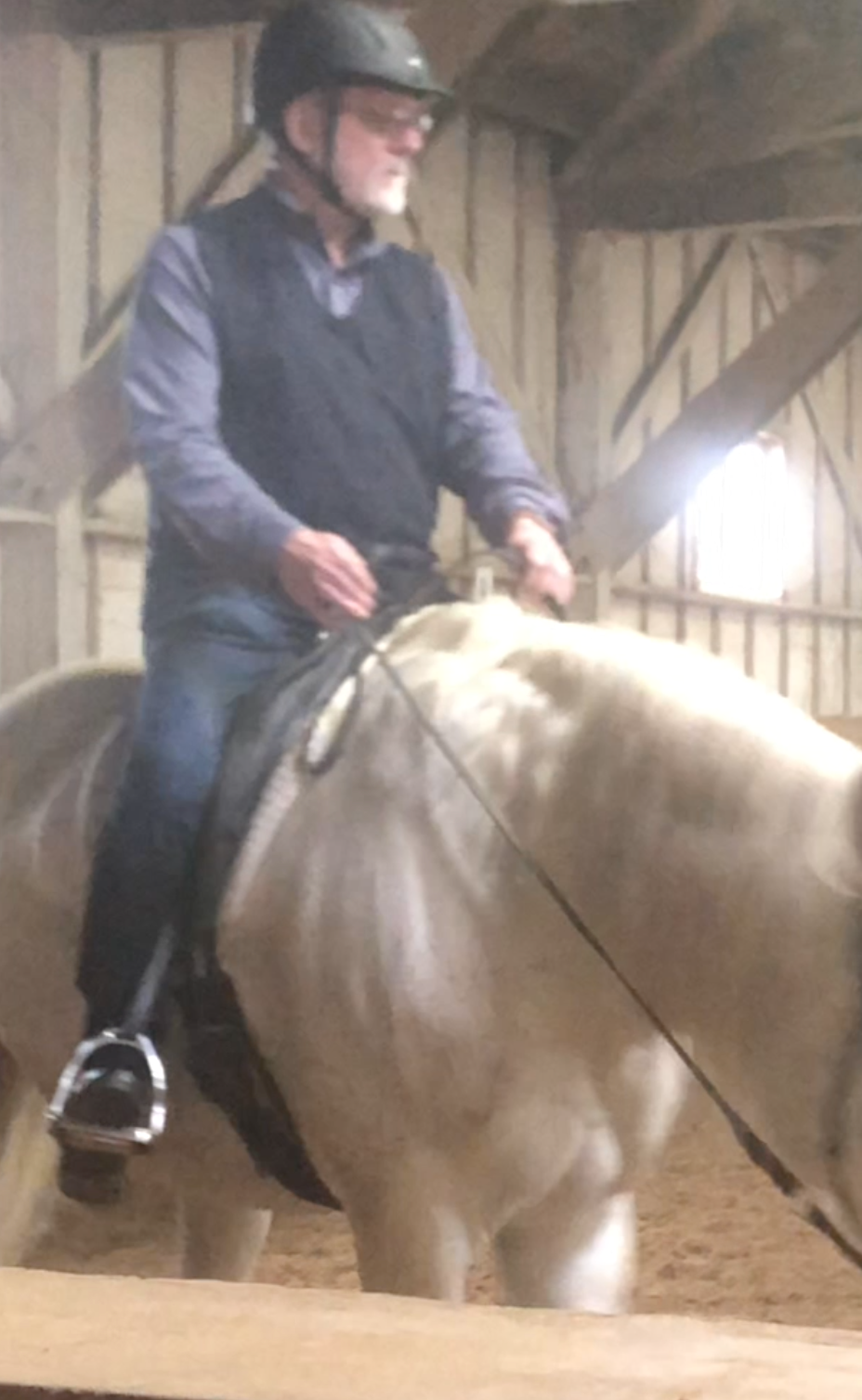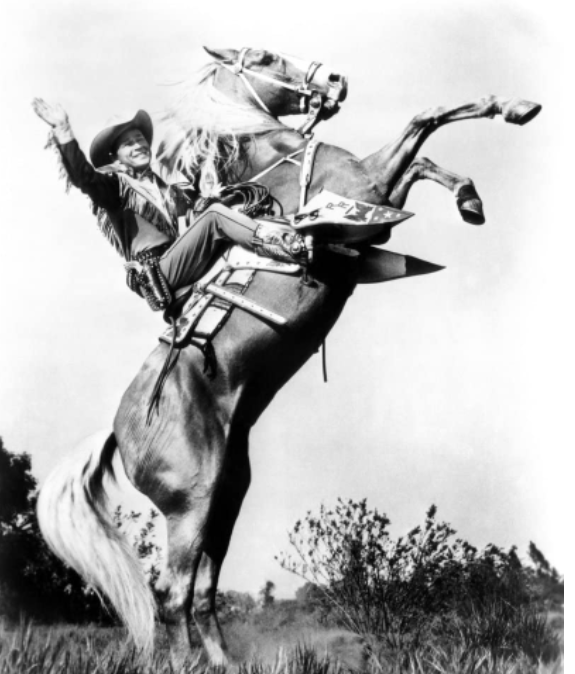Guess what I did today...my horsey adventures
-
Everything wrong with this picture:
My reins are MUCH too long, allowing her to lower her head too much. So, if I ask her for more "energy" to pick up a trot, she'll probably just slow down more.
Her ears are forward and she's not paying attention to me.
My stirrups are probably a bit too short, causing me to put too much weight on my feet, and not using my knees enough.
At least I'm not looking down at her head, and rather where I want to go.
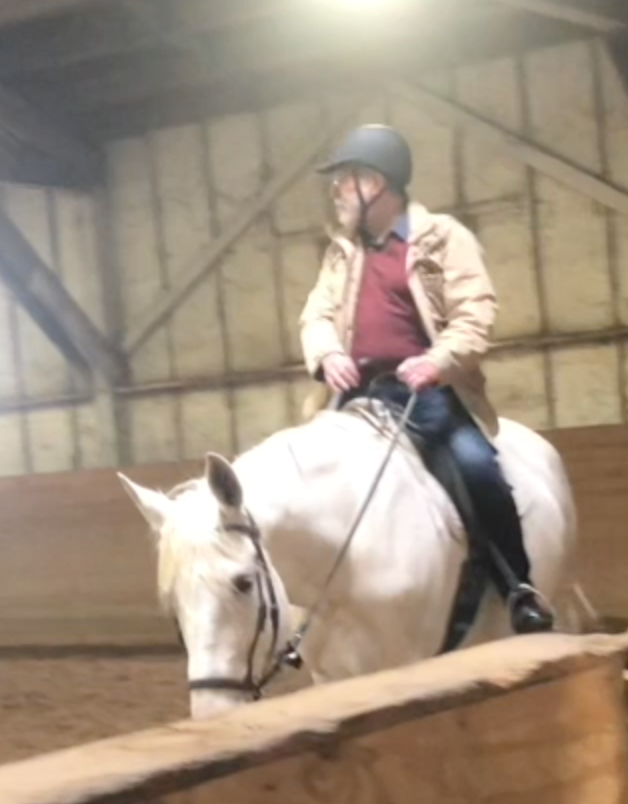
15 minutes later:
Reins are shorter. Her head is up, and look at her ears. Of course, "pinned ears" are a sign of aggression, but her's aren't pinned. They're turned back toward me, paying attention to what I'm going to ask her next.
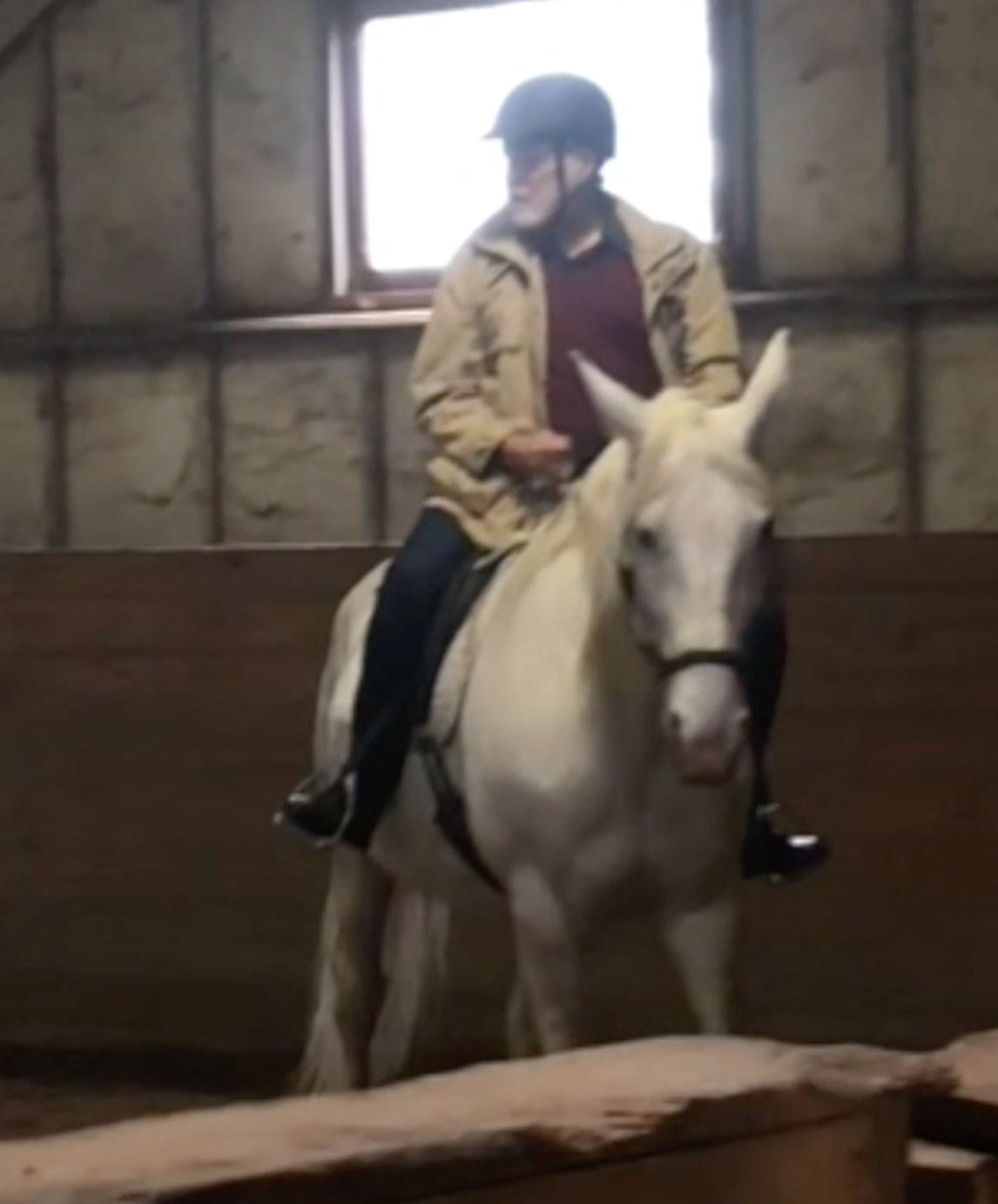
Yeah, I know, my right stirrup is shorter than my left...
-
Yay! You and the horse are getting to know each other. I am not much experienced with horses, but I have ridden a few times. I am impressed by those who have the skill to ride well, and I can imagine it's fun exercise for both horse and rider.
Love the pics, too!

-
It was a most interesting day, to be sure.
She has Mrs. George and me do totally different things. For Mrs. George, she had her stop the horse, step backward about 3 steps and then, go into the trot with only 2-3 steps at the walk. It's a way of getting the horse's attention, getting it to learn that "something is about to happen, so pay attention." The horse Mrs. George rode is a lot less "enthusiastic" about work than mine.
This was, as I said, only my second lesson, and I was a lot more comfortable on this mare. With me, she had me do a "turn on the forehand." It means having the horse keep it's forelegs in the same location, while asking it to swing its hindquarters 180 degrees. The goal is to have the forefeet move only so much as to keep then from tangling up. It's harder than you think, because you have to keep the horse from stepping forward. So, it's a combination of leg cue, rein, and body position.
-
@Copper said in Guess what I did today...:
The pose needs work
If you look at the bit that's in Trigger's mouth, you'll see that it's what's called a "curb" bit. It has a pair of long shanks which are attached to the reins. Those shanks increase the leverage that the rider has, and can exert more, a LOT more, pressure on the bit in the horse's mouth.
Sometimes the bit in the horse's mouth has all kinds of strange configurations which can cause pressure, or pain. Incorrect use of a curb bit can be painful to the horse.
I've never ridden a horse with that kind of contraption. Both of our horses had a "snaffle" bit. It's a hinged piece of metal that sits in the horse's mouth, and it is connected to the reins by a set of rings. Pulling on the reins simply pulls the bit back into the horse's mouth, and doesn't do anything to the palate of the horse. The rings, which sit on the "cheek" of the horse give some pressure to the cheek. Horses are trained to move away from pressure. So, if I pull on the right rein, the left cheek gets pressure and the horse turns his head to the right. This is a matter of training,
A related method of training (as I mentioned above) is "neck reining." Once the horse is trained to move away from pressure, it becomes relatively simple to train it to turn its head away from the rein which is rested against its neck. So, if I'm riding Western style, resting the rein on the horse's neck on it's left, will tell the horse to turn its head to the right (away from pressure). This type of training was critically important for the Spanish vaqueros who used their horses as working animals to herd cattle. The Spanish vaqueros were considered the consummate horsemen of the American plains.
(By the way, vaquero became corrupted into "buckaroo.")
All that goes out the window when you're riding English style. The saddle is smaller, there is no horn (that's not used to hang on to, it's there to "dally up" your rope so you can rope a steer). The stirrups are smaller and your style is to ride with two hands, rather than one. You use each hand to steer, and neck-reining simply doesn't exist. Gentle tug on one side will tell the horse which way you want to go. However, if you're good, and the horse is good, simply turning your head will torque your body enough that the horse senses a shift in weight. Turn your head to the right, and you'll put subtle pressure on your left hip. The horse senses that, and ... moves away from pressure on the left, and turns right.
Today's horse, the mare Opal, was ridden without a bit in her mouth. She's good enough that simply putting some pressure on her nose tells her what you want.
By the end of today's lesson, I got to the point where, at a walk, I could simply look at where I wanted to go, and with no leg or rein cue, I could steer her. My fat ass was enough pressure for her.
Looking forward to next week's lesson.
I miss owning a horse.
-
Here's what I was talking about with regards to the type of bit in a horse's mouth.
As I said, we always rode our guys in a snaffle. Simon was so good, however, that I sometimes rode him in a hackamore (basically a bitless bridle)
Snaffle.

Curb Bit.
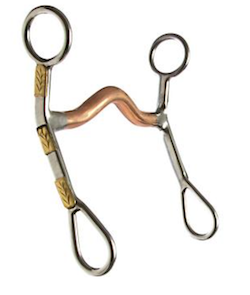
A more aggressive curb bit. How'd you like that pushing up against your palate?
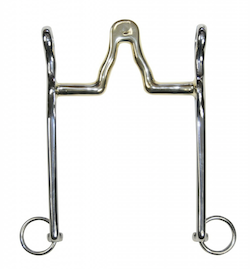
-
@Catseye3 said in Guess what I did today...:
Link to videoAnd barrel racing!
So many people in the horse world look down on other disciplines. What they don't get is that it's ALL about horsemanship.
If you're a hunter-jumper, you're going to look down on any Western rider, because, well, what's the point of the horn?
If your a dressage nazi, you'll look down on hunter-jumpers, because, well, all you gotta do is hold on while the horse jumps over some sticks, right?
If you're a barrel racer, you'll look down on reiners (like Shatner) because, c'mon man, you gotta go FAST!!!
If you're a reiner, you'll look down on the dressage-nazis because, well, it's the 21st century, man!
But the point I'm making is that all of these disciplines are evolved from a specific need for the horse to perform its job. "Dressage" means "training." And training a horse for warfare was paramount, back in the day.
Reining and barrel racing are evolved from the days of the vaquero.
It's all about the communication between horse and rider, and the skill and talent in each.
Also, as Churchill said, "There's nothing better for the inside of a man than the outside of a horse."
I really miss Simon. A lot.
-
@Catseye3 said in Guess what I did today...:
Link to videoAnd barrel racing!
So many people in the horse world look down on other disciplines. What they don't get is that it's ALL about horsemanship.
If you're a hunter-jumper, you're going to look down on any Western rider, because, well, what's the point of the horn?
If your a dressage nazi, you'll look down on hunter-jumpers, because, well, all you gotta do is hold on while the horse jumps over some sticks, right?
If you're a barrel racer, you'll look down on reiners (like Shatner) because, c'mon man, you gotta go FAST!!!
If you're a reiner, you'll look down on the dressage-nazis because, well, it's the 21st century, man!
But the point I'm making is that all of these disciplines are evolved from a specific need for the horse to perform its job. "Dressage" means "training." And training a horse for warfare was paramount, back in the day.
Reining and barrel racing are evolved from the days of the vaquero.
It's all about the communication between horse and rider, and the skill and talent in each.
Also, as Churchill said, "There's nothing better for the inside of a man than the outside of a horse."
I really miss Simon. A lot.
-
@George-K "And training a horse for warfare was paramount, back in the day."
I saw the Royal Lipizzaner Stallions once. What a thrill.
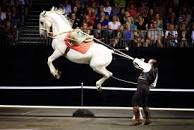
@Catseye3 in the video I posted, just watch the first ride.
EVERYONE knows their job. The horse knows which barrel to go around, and in what direction.
Talk about balance? That girl is AMAZING. She's not glued to the saddle, she floats above it. She is fearless at 25 mph on a half-ton beast.
The saddle? The horn serves no purpose in her horsemanship. And neither does her hat, or her boots. But boy, can she ride.
-
Dressage? Here's some Western dressage.
Watch this guy who is absolutely glued to his saddle. Smooth as can be.
Link to videoOh, I said dressage....
Link to videoOnce again, horse and rider are totally together. No effort on either is obvious. Remarkable stuff.
By the way, these are $100K horses.
Are the costumes silly? Of course they are - in all disclipines. But, when you think about it, it's no more silly than Riccardo Muti wearing tails, or bare-chested Roger Daltry.
It's the culture.
I miss Simon, so much.
-
@Catseye3 in the video I posted, just watch the first ride.
EVERYONE knows their job. The horse knows which barrel to go around, and in what direction.
Talk about balance? That girl is AMAZING. She's not glued to the saddle, she floats above it. She is fearless at 25 mph on a half-ton beast.
The saddle? The horn serves no purpose in her horsemanship. And neither does her hat, or her boots. But boy, can she ride.
-
@George-K Dick Francis, writer of great crime novels set in all aspects of the horse world, was the Queen Mother's Steeplechase Jockey before he retired. He went over fences at 35 mph!
Hard to imagine.
@Catseye3 said in Guess what I did today...:
over fences at 35 mph!
Hard to imagine.
A horse's trot is only about 10 mph. A lope is probably about 15, and a brisk canter is 20 or so. Full out gallop? 25 mph.
Simon was such a good horse - I could take him off the property and walk and trot though the subdivisions in the area. There was a long grassy stretch (about half a mile) and I'd always ask him for a canter there. After a few times, every time we went there, he'd pick up a canter without me even asking.
Such a good boy.
@Renauda will attest that there are few things better than a good, reliable horse.
Our other horse, Gulliver, was an idiot. Coming off of him, at speed, was the only time I hurt myself on a horse.
Well, actually coming off a horse...
-
@Copper said in Guess what I did today...:
The pose needs work
If you look at the bit that's in Trigger's mouth, you'll see that it's what's called a "curb" bit. It has a pair of long shanks which are attached to the reins. Those shanks increase the leverage that the rider has, and can exert more, a LOT more, pressure on the bit in the horse's mouth.
Sometimes the bit in the horse's mouth has all kinds of strange configurations which can cause pressure, or pain. Incorrect use of a curb bit can be painful to the horse.
I've never ridden a horse with that kind of contraption. Both of our horses had a "snaffle" bit. It's a hinged piece of metal that sits in the horse's mouth, and it is connected to the reins by a set of rings. Pulling on the reins simply pulls the bit back into the horse's mouth, and doesn't do anything to the palate of the horse. The rings, which sit on the "cheek" of the horse give some pressure to the cheek. Horses are trained to move away from pressure. So, if I pull on the right rein, the left cheek gets pressure and the horse turns his head to the right. This is a matter of training,
A related method of training (as I mentioned above) is "neck reining." Once the horse is trained to move away from pressure, it becomes relatively simple to train it to turn its head away from the rein which is rested against its neck. So, if I'm riding Western style, resting the rein on the horse's neck on it's left, will tell the horse to turn its head to the right (away from pressure). This type of training was critically important for the Spanish vaqueros who used their horses as working animals to herd cattle. The Spanish vaqueros were considered the consummate horsemen of the American plains.
(By the way, vaquero became corrupted into "buckaroo.")
All that goes out the window when you're riding English style. The saddle is smaller, there is no horn (that's not used to hang on to, it's there to "dally up" your rope so you can rope a steer). The stirrups are smaller and your style is to ride with two hands, rather than one. You use each hand to steer, and neck-reining simply doesn't exist. Gentle tug on one side will tell the horse which way you want to go. However, if you're good, and the horse is good, simply turning your head will torque your body enough that the horse senses a shift in weight. Turn your head to the right, and you'll put subtle pressure on your left hip. The horse senses that, and ... moves away from pressure on the left, and turns right.
Today's horse, the mare Opal, was ridden without a bit in her mouth. She's good enough that simply putting some pressure on her nose tells her what you want.
By the end of today's lesson, I got to the point where, at a walk, I could simply look at where I wanted to go, and with no leg or rein cue, I could steer her. My fat ass was enough pressure for her.
Looking forward to next week's lesson.
I miss owning a horse.
@George-K said in Guess what I did today...:
A related method of training (as I mentioned above) is "neck reining." Once the horse is trained to move away from pressure, it becomes relatively simple to train it to turn its head away from the rein which is rested against its neck. So, if I'm riding Western style, resting the rein on the horse's neck on it's left,
Yeah, I'm in an English saddle, and wearing English-style half-chaps, but Simon was trained to neck-rein.
Here, I'm asking him for a left turn, just using the pressure of the reins on his right neck.
This is about 20 years ago.
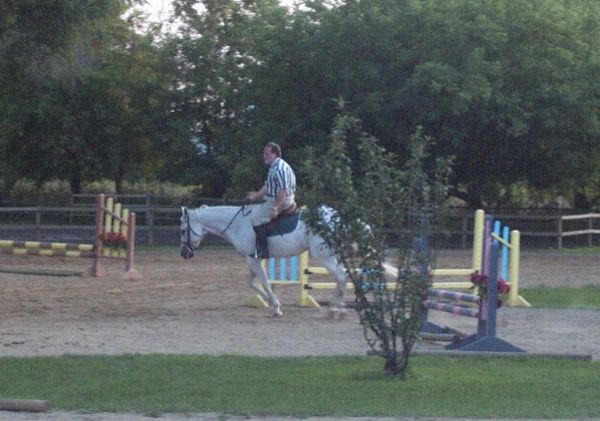
-
@Catseye3 said in Guess what I did today...:
Link to videoAnd barrel racing!
So many people in the horse world look down on other disciplines. What they don't get is that it's ALL about horsemanship.
If you're a hunter-jumper, you're going to look down on any Western rider, because, well, what's the point of the horn?
If your a dressage nazi, you'll look down on hunter-jumpers, because, well, all you gotta do is hold on while the horse jumps over some sticks, right?
If you're a barrel racer, you'll look down on reiners (like Shatner) because, c'mon man, you gotta go FAST!!!
If you're a reiner, you'll look down on the dressage-nazis because, well, it's the 21st century, man!
But the point I'm making is that all of these disciplines are evolved from a specific need for the horse to perform its job. "Dressage" means "training." And training a horse for warfare was paramount, back in the day.
Reining and barrel racing are evolved from the days of the vaquero.
It's all about the communication between horse and rider, and the skill and talent in each.
Also, as Churchill said, "There's nothing better for the inside of a man than the outside of a horse."
I really miss Simon. A lot.
@George-K said in Guess what I did today...:
@Catseye3 said in Guess what I did today...:
Link to videoAnd barrel racing!
So many people in the horse world look down on other disciplines. What they don't get is that it's ALL about horsemanship.
If you're a hunter-jumper, you're going to look down on any Western rider, because, well, what's the point of the horn?
If your a dressage nazi, you'll look down on hunter-jumpers, because, well, all you gotta do is hold on while the horse jumps over some sticks, right?
If you're a barrel racer, you'll look down on reiners (like Shatner) because, c'mon man, you gotta go FAST!!!
If you're a reiner, you'll look down on the dressage-nazis because, well, it's the 21st century, man!
But the point I'm making is that all of these disciplines are evolved from a specific need for the horse to perform its job. "Dressage" means "training." And training a horse for warfare was paramount, back in the day.
Reining and barrel racing are evolved from the days of the vaquero.
It's all about the communication between horse and rider, and the skill and talent in each.
Also, as Churchill said, "There's nothing better for the inside of a man than the outside of a horse."
I really miss Simon. A lot.
My niece had two horses, a thoroughbred for jumping (or whatever y'all call it when y'all put on them pancake saddles and wear them funny hats and coats) and a quarter horse for barrels.
Ryan is dead and buried on the farm, so no more jumping, but she'll still head out to the local rodeo and compete on barrels every now and then.
As long as it's a horse, she's in her element. She does love them so.
-
Lesson #3 today.
The jump in improvement between #1 and #2 was not apparent today. Progress was incremental.
I rode Opal again, and she's a pretty good mare. However, if you're not really asking her to pay attention - stay on the rail, don't cut the corners, keep trotting - she'll do whatever the hell she wants to do. And that means, slowing down, or even stopping.
But those are good things, because they require more of me as a rider. I must pay attention, because she won't. I must anticipate what my next move will be, like a turn, because if I'm not thinking about it, it'll be too late.
As I mentioned elsewhere, D2 came along today, and while watching Mrs. George ride, she commented, "This is pretty complicated stuff - leg, knee, thigh, watch where you're going. It's not at all 'hop on and ride' like a trail horse."
Yeah...
Riding a trail horse is a totally different experience. The horse follows the horse in front of it, and that is the horse's focus. If it trots, it'll trot. If the horse in front is walking the trail, it'll do the same. In an arena, with no "goal" or "focus" the horse relies on you to tell it what you do.
And that's work. It's up to YOU to pay attention, support the horse, and tell it what you expect. Arena riding can be boring, and until you start doing things more complicated than just going in a circle, the horse will try to do the easiest thing possible.
Here, I'm about to ask her to turn to the right. Look at where I'm looking (to the right) and look at her ears. They're rotated back, indicating that she's paying attention to what I'm doing and asking.
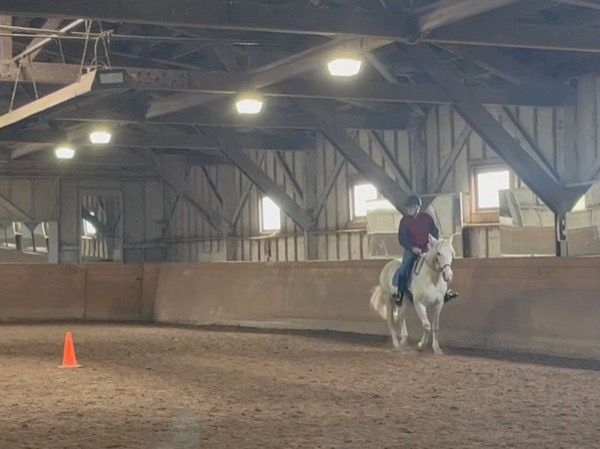
I'll keep annoying you guys with this until you tell me to shut up...
-
Lesson #3 today.
The jump in improvement between #1 and #2 was not apparent today. Progress was incremental.
I rode Opal again, and she's a pretty good mare. However, if you're not really asking her to pay attention - stay on the rail, don't cut the corners, keep trotting - she'll do whatever the hell she wants to do. And that means, slowing down, or even stopping.
But those are good things, because they require more of me as a rider. I must pay attention, because she won't. I must anticipate what my next move will be, like a turn, because if I'm not thinking about it, it'll be too late.
As I mentioned elsewhere, D2 came along today, and while watching Mrs. George ride, she commented, "This is pretty complicated stuff - leg, knee, thigh, watch where you're going. It's not at all 'hop on and ride' like a trail horse."
Yeah...
Riding a trail horse is a totally different experience. The horse follows the horse in front of it, and that is the horse's focus. If it trots, it'll trot. If the horse in front is walking the trail, it'll do the same. In an arena, with no "goal" or "focus" the horse relies on you to tell it what you do.
And that's work. It's up to YOU to pay attention, support the horse, and tell it what you expect. Arena riding can be boring, and until you start doing things more complicated than just going in a circle, the horse will try to do the easiest thing possible.
Here, I'm about to ask her to turn to the right. Look at where I'm looking (to the right) and look at her ears. They're rotated back, indicating that she's paying attention to what I'm doing and asking.

I'll keep annoying you guys with this until you tell me to shut up...
@George-K Interesting stuff. Please contineu
-
Keep going. Your knowledge and connection with horses is fascinating. I've ridden more than most probably have, but never had any real instruction.
